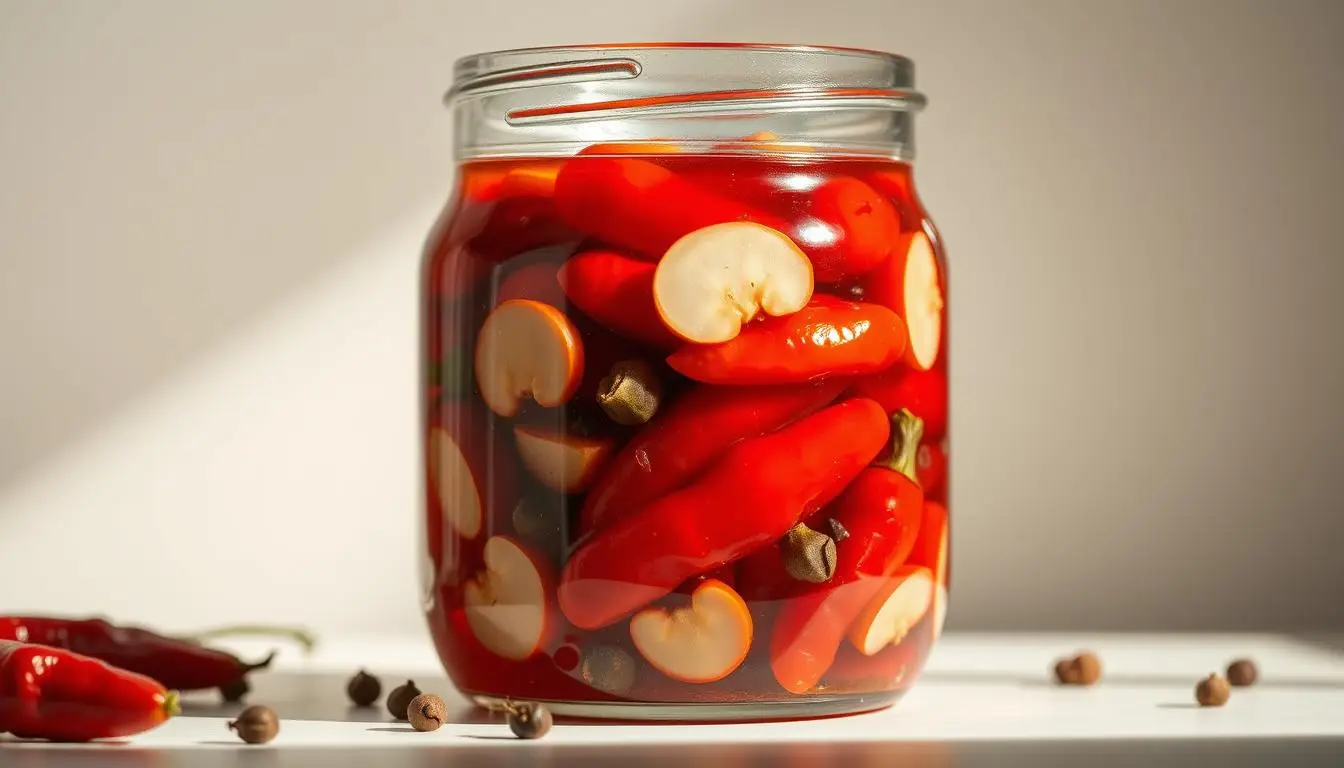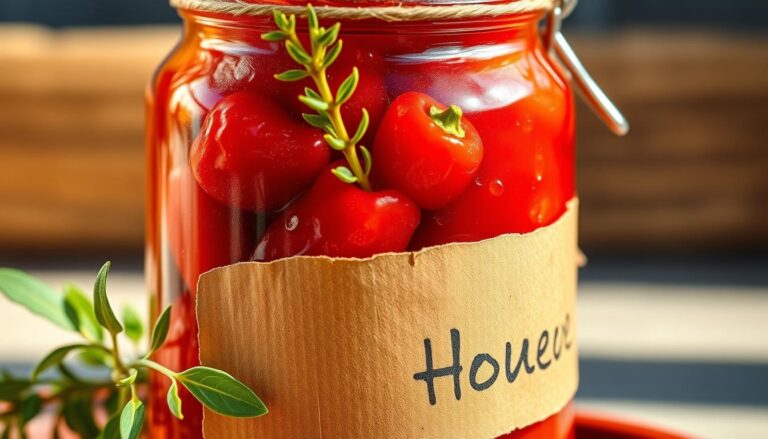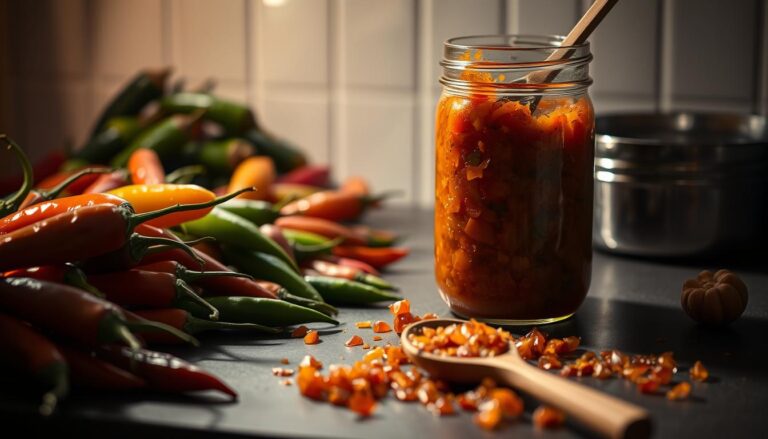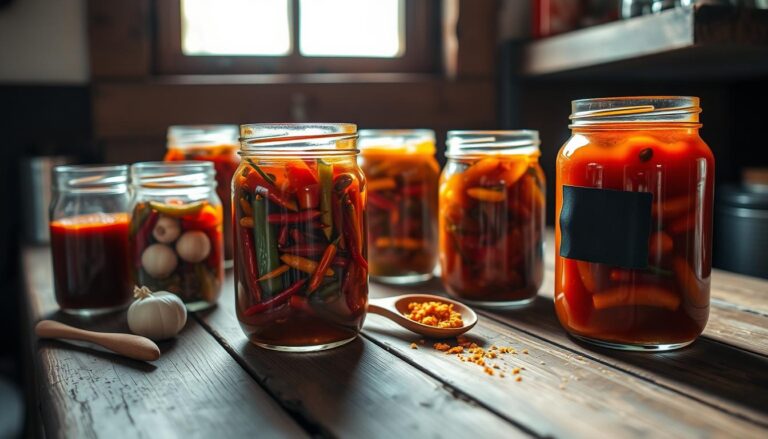How to Ferment Peppers: The Process for Delicious Hot Sauce
Table of Contents
Fermenting hot peppers turns simple peppers into a vibrant, complex condiment. It adds depth and tanginess to your dishes. This art form is key to elevating your cooking.
Starting to ferment hot peppers opens a world of flavor. The fermentation process creates rich, nuanced tastes. These are far beyond what you find in store-bought hot sauces.
Each type of pepper, from jalapeños to ghost peppers, has its own unique flavor. This makes homemade fermented peppers a game-changer for your meals.
Fermenting hot peppers is more than just adding heat. It’s about creating a complex condiment that enhances your dishes. Whether it’s topping eggs, adding to tacos, or making a signature sauce, the taste is unmatched.
Understanding fermentation science is key to making delicious results. It involves beneficial bacteria turning peppers into a tangy, probiotic-rich sauce. This sauce is both tasty and healthy.
In this guide, you’ll learn all about fermenting peppers. From choosing the right ingredients to mastering the technique, it’s all here. Get ready for a flavorful journey that will change your cooking forever.
Understanding Fermented vs Regular Hot Sauce
Dive into the world of fermented hot sauces. Here, traditional cooking meets scientific magic. Exploring fermenting bell peppers and chili peppers unlocks a culinary experience. It transforms ordinary peppers into extraordinary condiments.
Fermentation is a natural way to preserve food. It creates complex flavors not found in regular hot sauces. During fermentation, beneficial bacteria turn pepper sugars into lactic acid. This makes the sauce tangy and sophisticated.
The Science Behind Fermentation
Lacto-fermentation uses special bacteria to work on peppers. The process has several stages:
- Initial stage: Leuconostoc mesenteroides dominates (1-3 days)
- Middle stage: Lactobacillus plantarum takes over (Days 4-10)
- Late stage: Pediococcus species refine flavors (Days 11+)
Benefits of Fermented Hot Sauce
Fermented hot sauces have many benefits:
- Increased probiotic content
- Enhanced nutritional value
- Extended shelf life (up to one year)
- Deeper, more complex flavor profile
Flavor Profile Differences
Fermented hot sauces have a unique umami taste. Unlike vinegar-based sauces, they break down sugars. This creates nuanced flavors that enhance your meals.
“Fermentation is not just cooking; it’s culinary alchemy.” – Fermentation Expert
With fermentation temperatures between 68-72°F, you can make amazing sauces. These sauces will excite your taste buds.
Essential Equipment and Ingredients
Fermenting jalapenos and other spicy peppers needs the right tools and ingredients. Start your journey by getting the necessary equipment and fresh ingredients. This will help you make a tasty homemade hot sauce.
- Wide-mouth mason jars (1-quart size recommended)
- Fermentation weights
- Breathable fermentation lids
- Non-iodized sea salt
- Non-chlorinated water
When picking peppers, keep these tips in mind:
- Go for fresh, firm peppers without blemishes
- Jalapeños are great for fermenting spicy peppers
- Try mixing different pepper varieties for unique flavors
“The quality of your ingredients directly impacts the final fermented hot sauce” – Fermentation Experts
Optional ingredients to boost flavor include:
- Garlic cloves (2 recommended)
- Sliced onions
- Herbs like oregano or cilantro
| Ingredient | Quantity | Purpose |
|---|---|---|
| Jalapeños | 6 peppers | Primary fermentation base |
| Sea Salt | 1 tsp per cup of water | Fermentation preservation |
| Garlic | 2 cloves | Flavor enhancement |
| Water | 2 cups | Brine solution |
Your fermentation setup needs a consistent temperature of 68-72°F for best results. Proper equipment and ingredient selection are key for successful fermenting of spicy peppers.
How to Ferment Peppers: Step-by-Step Guide
Fermenting peppers is a fun journey that turns simple ingredients into a tangy condiment. Whether you’re new to fermenting peppers or want to try fermenting habaneros, this guide will help you every step of the way.
- Clean glass jars
- Filtered water
- Sea salt or pickling salt
- Fresh peppers
- Fermentation weights
Preparing Your Peppers
Begin by washing your peppers well. When working with spicy peppers like habaneros, wear gloves to avoid skin irritation. Cut the peppers into equal pieces, removing stems and any bad spots. Consistency is key for even fermentation.
Creating the Perfect Brine
The perfect brine for fermenting peppers is 3% salt in water. For every quart of water, add 3 tablespoons of salt. Remember, use filtered water for a clean fermentation.
Fermentation Setup
Fill your jars with peppers, leaving about an inch at the top. Pour the brine over the peppers to cover them completely. Use weights to keep the peppers under the brine and prevent mold.
- Cover jar with a lid or airlock
- Store at room temperature (65-70°F)
- Ferment for 5-7 days
- Check daily and remove any surface scum
Once fermented, keep your peppers in the fridge. They’ll last for months. Enjoy them in salsas, sandwiches, or as a tasty condiment!
Choosing the Right Peppers for Fermentation
When you start fermenting peppers, picking the right ones is key. Poblanos and serranos give your hot sauce a unique taste. This can change how you enjoy food.
Peppers add different things to your fermentation. Think about these important points when picking your peppers:
- Heat Level: Know the Scoville Heat Units (SHU) of your peppers
- Flavor Profile: Look for fruity, earthy, or floral tastes
- Physical Properties: Check the thickness and moisture of the flesh
For a great hot sauce, mix peppers with different heat levels. Poblanos have a mild, smoky taste with 1,000-1,500 SHU. Serranos have a sharp kick, from 10,000-25,000 SHU. Together, they add depth and complexity to your sauce.
Here are some top peppers for fermentation:
- Jalapenos (2,500-8,000 SHU)
- Serrano peppers (10,000-25,000 SHU)
- Poblano peppers (1,000-1,500 SHU)
- Cayenne peppers (30,000-50,000 SHU)
Pro tip: Don’t use peppers over 500,000 SHU. Their high capsaicin can stop fermentation. Choose peppers that let good bacteria grow for that tangy, spicy taste.
Salt Ratios and Brine Solutions
Mastering the art of fermenting hot peppers and bell peppers needs careful salt ratios and brine solutions. The right brine is key for delicious fermented hot sauce. It should be full of flavor and probiotics.
Understanding Salt Percentages
When fermenting peppers, salt concentration is very important. The best salt range is between 2-3% by weight of water. This range helps beneficial bacteria grow while keeping harmful ones away.
- 2% salt concentration: Recommended for milder peppers
- 3% salt concentration: Ideal for hot pepper fermentation
- Never go below 1% salt to prevent fermentation failure
Water Quality Requirements
Your water is as important as your salt. Use filtered or non-chlorinated water for success. Chlorine can stop beneficial bacteria from growing, which is bad for your fermented hot sauce.
Measuring and Mixing Brine
| Pepper Type | Salt Percentage | Salt per Liter of Water |
|---|---|---|
| Bell Peppers | 2% | 20 grams |
| Hot Peppers | 3% | 30 grams |
For exact measurements, use a digital scale. Pro tip: To get 2.5% salt, multiply your water weight in grams by 0.025. Remember, being consistent is important in fermenting peppers!
“Salt is the secret weapon in pepper fermentation, transforming simple ingredients into complex, tangy delights.” – Fermentation Expert
Monitoring the Fermentation Process
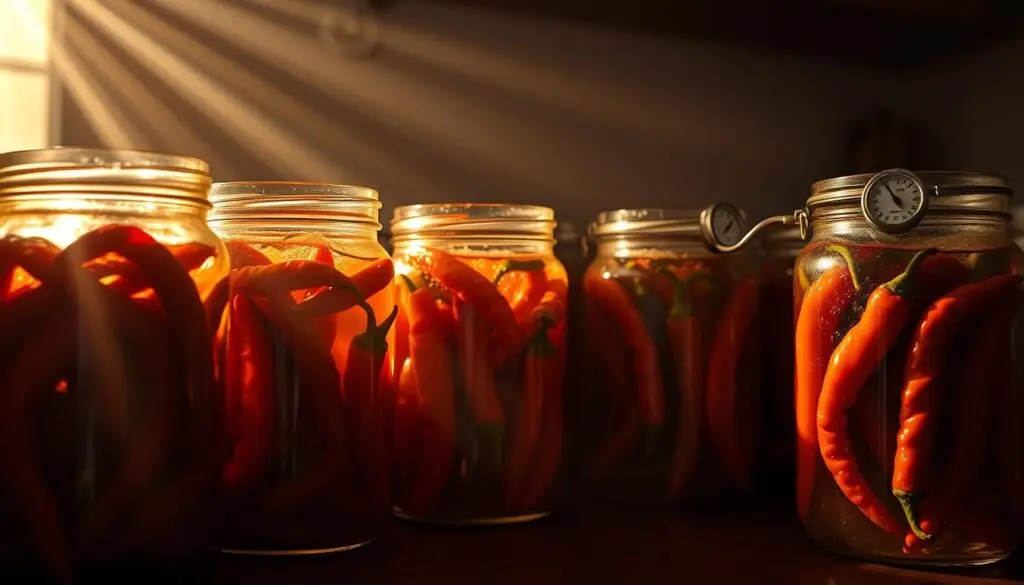
Fermenting chili peppers is an art that needs careful watching and patience. It turns your spicy peppers into a rich, flavorful condiment. This happens through a careful dance of bacteria.
During fermentation, you’ll see several important signs:
- Bubbling in the jar
- Slight color changes in the peppers
- Developing tangy aroma
- Softening of pepper texture
Temperature is key in fermenting spicy peppers. The best range is 68-72°F (20-22°C). If it’s too hot or cold, it can change how fast or slow fermentation goes, affecting the taste.
pH levels are also very important. Your ferment will start around pH 6.5 and go down to 3.4-3.8. This drop in acidity shows your ferment is working well and keeps your hot sauce fresh.
Pro tip: Use a pH strip or digital meter to track your fermentation progress accurately.
Most ferments take 1-2 weeks to get their full flavor. Try your ferment often to see how it’s changing. The longer it ferments, the more complex and tangy it gets.
Keep an eye out for any mold or strange colors. These could mean something’s gone wrong. A good ferment should smell slightly sour and have a consistent color.
Common Problems and Solutions
Fermenting jalapenos or habaneros can come with challenges. Knowing these issues helps you make a great hot sauce. It ensures your fermentation goes smoothly.
Dealing with Kahm Yeast
Kahm yeast is a common problem when fermenting peppers. It looks scary but is usually safe. Just scrape it off. To avoid kahm yeast, keep things clean and use the right salt ratio.
- Maintaining a clean fermentation environment
- Using proper salt ratios
- Keeping peppers completely submerged in brine
Preventing Mold Growth
Mold can spoil your peppers and be unhealthy. Watch for fuzzy or discolored spots. To stop mold, use clean tools and keep peppers under water.
- Using sterilized equipment
- Ensuring peppers remain fully underwater
- Monitoring fermentation temperature
Troubleshooting Tips
Pepper fermentation needs attention. Here’s a quick guide for common problems:
| Problem | Potential Cause | Solution |
|---|---|---|
| Off-odors | Improper salt concentration | Adjust brine, restart if necessary |
| Discoloration | Exposure to air | Ensure peppers are fully submerged |
| Weak fermentation | Low ambient temperature | Move to warmer location |
Remember, patience and careful observation are key to successful pepper fermentation!
Creating Hot Sauce from Fermented Peppers
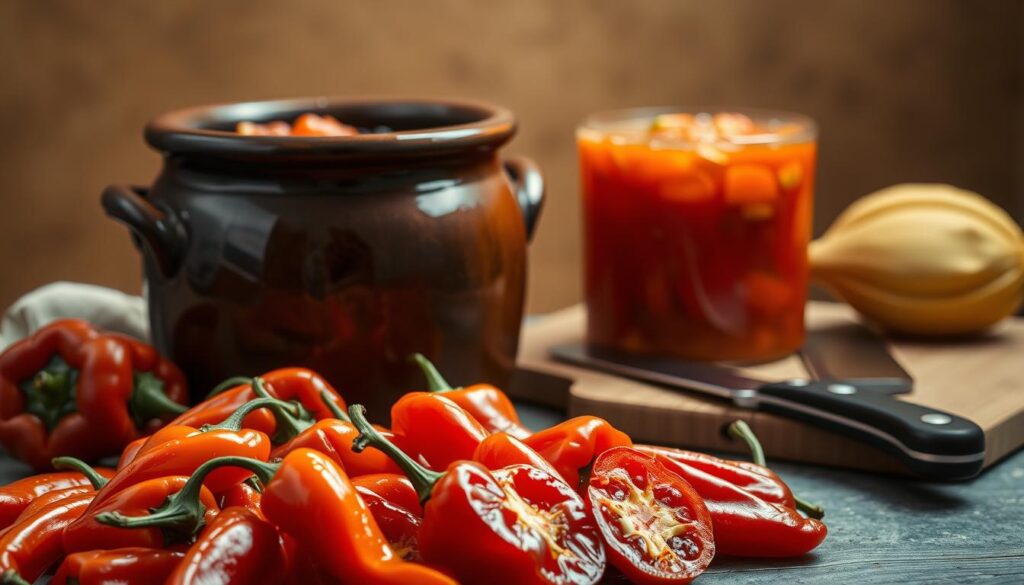
Turning your fermented serranos and poblanos into hot sauce is a fun journey. The fermentation brings out deep, complex flavors. These flavors make your sauce stand out from the usual.
To make your hot sauce, you’ll need some basic tools:
- Food processor or blender
- Fine-mesh strainer (optional)
- Glass bottles for storage
Begin by draining your fermented peppers and saving some brine. Then, blend the peppers with these important ingredients:
- Fermented peppers
- Reserved fermentation brine
- White vinegar
- Salt to taste
You can also add:
- Garlic for depth
- Honey for sweetness
- Onions for complexity
Blend until it’s smooth. Strain it if you want a thinner sauce. Remember, fermented peppers already have a tangy, rich taste. This makes your hot sauce special.
Pro tip: Try mixing different peppers for unique flavors!
Store your homemade hot sauce in clean glass bottles in the fridge. It can last up to 6 months. The best flavors come out in the first 3 months.
Flavor Variations and Recipes
Fermenting hot peppers can turn simple recipes into gourmet hot sauces. By trying new flavor combinations, you can create unique tastes. This goes beyond the usual hot sauce flavors.
Try these ways to enhance the flavor of your fermented hot peppers:
- Add calcium chloride (0.1%) to keep peppers crisp
- Use whey to seed bacteria
- Include herbal tea for tannin complexity
- Introduce spices at key fermentation stages
Choosing the right pepper variety is key. Serrano peppers are great for making robust flavors. They have a heat level of 10,000 to 23,000 Scoville Heat Units.
| Pepper Type | Heat Level | Flavor Profile |
|---|---|---|
| Serrano | 10,000-23,000 SHU | Sharp, bright |
| Jalapeno | 2,500-8,000 SHU | Grassy, mild |
| Habanero | 100,000-350,000 SHU | Fruity, intense |
Keep fermentation temperatures between 55-75 degrees Fahrenheit. This is best for flavor. The most active fermentation time is 1-2 weeks. Some people ferment for up to 6 months for deeper flavors.
Pro tip: Aim for a pH level below 4.6, with 3.7 being ideal for shelf-stable fermented hot sauces.
Storing and Using Fermented Peppers
Fermenting bell peppers and spicy peppers opens up a world of culinary possibilities. After completing your fermentation process, proper storage becomes key. It helps keep the flavor and probiotic benefits.
Your fermented peppers can be safely stored in the refrigerator for a long time. Unlike what many think, fermented foods don’t spoil. Instead, they change flavor over time.
- Refrigeration extends shelf life up to 1 year
- Keep peppers in glass containers with tight-fitting lids
- Use clean utensils when serving to prevent contamination
When storing fermenting spicy peppers, consider these key guidelines:
| Storage Method | Expected Duration | Flavor Changes |
|---|---|---|
| Refrigerated | Up to 12 months | Mellow, deepening complexity |
| Room Temperature | 2-3 weeks | Faster flavor transformation |
Creative uses for your fermented peppers include blending into hot sauces, adding to marinades, or incorporating into salsa. Pro tip: The longer fermented peppers rest, the softer their texture becomes.
Nutrition-wise, fermented peppers retain significant benefits. A typical serving provides about 405 IU of Vitamin A and 61mg of Vitamin C. They are a healthy addition to your diet.
Conclusion
Learning to ferment peppers is a fun journey that turns simple ingredients into tasty, healthy condiments. You’ll discover a world of flavors, from tangy hot sauces to vibrant condiments. These can make any meal better.
The journey of fermenting peppers needs patience and careful attention. The best temperature for fermentation is between 66-72°F. With time, you’ll get better at understanding how salt, temperature, and time mix to create amazing flavors.
Mastering fermented peppers is more than making a condiment. It’s about keeping a traditional method that makes food taste better and is healthier. Whether you use jalapeños, habaneros, or other peppers, your homemade fermented peppers will add a special kick to your dishes.
Begin your fermentation adventure today. Try different peppers and enjoy the tasty outcomes of your new skill. Your taste buds and your gut will appreciate this cooking method.
Chef Tools Recommended for Fermenting spicy Peppers:
- Digital kitchen scale
- Food processor
- sharp chef’s knife
- Wide-mouth mason jars
- Digital pH meter
- Fermentation weights
- Airlocks
Check This For More Homemade Fermenting Hot Peppers Recipes

